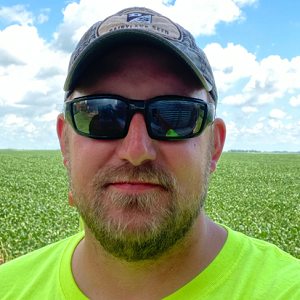Enlist E3® Soybeans Provide Weed Control Solution for North Dakota Farm
Luke Anderson of North Dakota takes farming seriously. He’s seen the need for new technology to control weeds, and he’s seen the value of Enlist E3® soybeans featured in the Enlist™ weed control system.
“About five years ago, it became almost impossible to control weeds with one herbicide,” Anderson says. “Waterhemp pressure was bad, and the weeds were showing resistance. We kept throwing chemistries at the problem, but it didn’t work. At the same time, Palmer amaranth kept creeping closer to our farm. We were not prepared for it.”
Anderson and his dad, Joel, began working with Dairyland Seed, which was developing varieties of Enlist E3 soybeans. They saw a value in the new technology.
“Adding a new 2,4-D product made sense,” Anderson says.
A passion for farming
Anderson’s farm roots run deep: He’s the fifth generation to operate the farm.
“I finished college and worked for a manufacturing company doing a lot of traveling,” he says. “I knew farming was my passion. It’s what I believed in. I just knew it was for me.”
Since coming back to join his father, he’s been looking for ways to control weeds without having to throw everything but the kitchen sink into the field.
“I think the way to use Enlist is to control early weeds with tillage then come back with a preemergence application that includes a residual,” he explains. “Ideally, we’d like to come back with Enlist Duo postemergence and not make a second post application unless necessary.”
Anderson realizes some years you just have to spray again to take care of persistent weeds, but he generally believes fewer passes through the field is better.
“The nice thing about the Enlist system is it gives us flexibility,” he notes. “We can use a program approach and get two more modes of action with Enlist Duo or with Enlist One mixed with glufosinate. We may be able to skip glyphosate some years. It’s nice to have options to change chemistries as we need to for weed control.”
Success reports raise confidence
Anderson has no concerns about Enlist™ herbicides drifting or volatilizing when he follows the label.
“The success cotton growers have had applying Enlist herbicides on Enlist cotton made me confident the technology would work with soybeans,” he says. “You just have to make plans and follow the label.”
Anderson and his father like to get ahead of weeds, not letting them get too tall before spraying. They’re following that philosophy with Enlist E3 soybeans. They sprayed Enlist Duo in the first part of July on a warm, muggy day when winds were at 10 mph.
“There was rain in the forecast and we needed to go to make sure we hit the weeds at the right height,” he says. “We had not one complaint, not one issue. There was no effect on nearby fields. On the same day, a nearby application of dicamba did cause some issues. It’s nice when you don’t get a call from your neighbor after you spray.”
Anderson says his neighbors are seeing the value of the Enlist weed control system.
“Most of the opportunities to plant Enlist E3 soybeans up to now have been for seed production,” Anderson notes. “As more guys try Enlist, I think it will surpass other weed control technologies in our area.”
